Murky as Hell, written and directed by Andrea L. Hart, takes audiences through a multi-leveled rehabilitation program, transitioning from an empty wasteland to a sterile training center as her protagonists wrestle with the demons of their past. Presented as part of UTNT (UT New Theatre), this multi-layered narrative structure culminates in an over-the-top fight to the death that draws inspiration from film, wrestling and coliseum battles of the past.
Without giving too much away, could you give us a brief overview of what the final scene is in context of the play?
Andrea L. Hart (Playwright/Director): The play is about (among other things) the culture of silence that is enforced around issues of sexual abuse specifically as it relates to the silence among enablers, accomplices and perpetrators. In the world of the play, certain characters are taking extreme measures to ensure the silence of another character. When they fail at their initial efforts, the only thing left to do is a battle to the death. That’s what brings us to the “Thunderdome.”
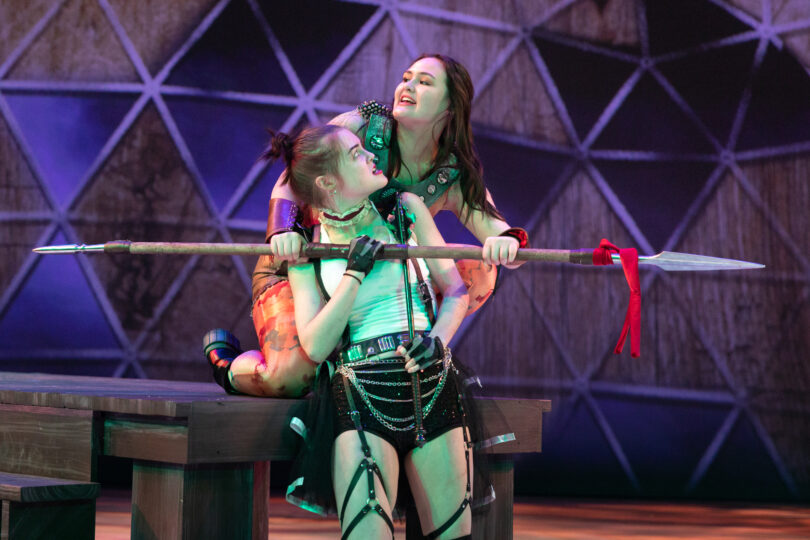
What, outside of design elements, are you using to create the “Thunderdome” scene? Can you discuss the elements of choreography at work here?
Andrea L. Hart (Playwright/Director): The “Thunderdome” scene is inspired by Mad Max, WrestleMania and Roman coliseum gladiator fights. We are using weapons you might expect to see in any of those locations and for that we needed someone skilled to teach us how to create something that felt brutal and violent, but was also, obviously, safe. We’ve been working with Tobie Minor to create those fight moments.
I don’t want to give too much away, but at some point another kind of fighter needed to enter the arena. A fighter that was skilled in the ways of silence and could approach the battle differently. For that we turned to Kelsey Oliver to choreograph another kind of “dance” battle.
What is the purpose of creating this large spectacle in the context of the play? How are you using spectacle as a tool to connect with audiences?

Andrea L. Hart (Playwright/Director): To me, that level of heightened reality and making it loud and ridiculous is meant to be in direct contrast to the violence of the silence I’m exploring. Or rather, it’s meant to express what that violence FEELS like, even as it’s left unsaid or kept silent. These situations fly under the radar, exist in plain sight and, to me, the only way to express the insanity of that is to blow it up.
Additionally, I think there are so many situations in life that are unfathomable and over-the-top but are passed off as normal or even entertaining. We are asked to cheer and clap along to something that tickles the opposite response in our stomachs. The “Thunderdome” is that moment on steroids. In some small way maybe it’s a chance to practice following that tickle in your stomach rather than the crowd around you… I’m curious to see how audiences respond. This is a play that really won’t be finished until I can see that.
Can you give us a brief description of the design elements for the final “Thunderdome” scene? What did you draw on for inspiration?
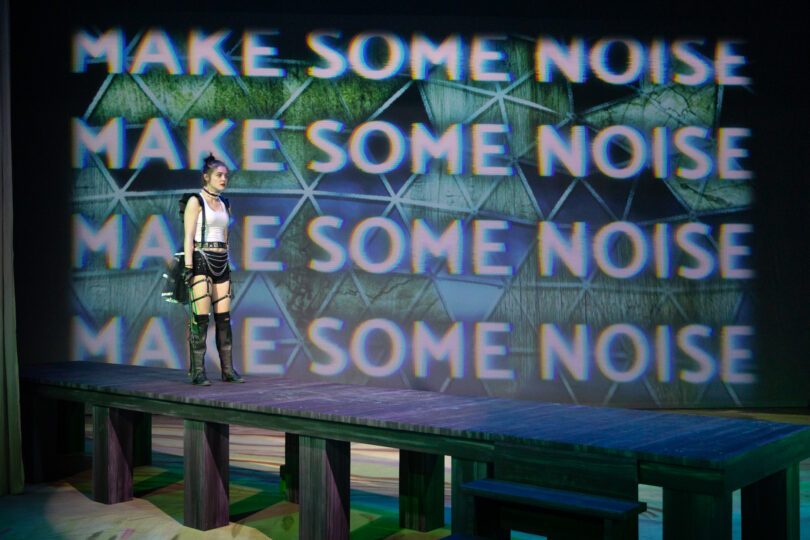
Zoey Crow (Projection Designer): My design for the “Thunderdome” was inspired by the concept of a jumbotron at a large arena event, like a football game or a WWE wrestling event. I was focused on finding ways to encourage the audience to participate and get involved during certain moments throughout the fights using phrases like “make some noise” and “get loud,” especially later on when the audience might be questioning whether they should even still be cheering.
Tobie Minor (Fight Choreographer): This scene is a Mad Max-esque version of a twisted landscape where you have to decide who is right and wrong using combat. We used a double-headed spear, a spiked mace and several other weapons to show the danger and severity that these characters are dealing with on a daily basis. This scene also takes place in part on an elevated platform. That presents its own issues and opportunities that we were able to play with and deal with while choreographing something that would be safe for actors who are not trained fighters.
Katie Miller (Costume Designer): The general look for the costumes in the “Thunderdome” is what I would call “pro-wrestling-meets-Burning-Man.” There is a sense of apocalyptic grittiness blended with the artificial. The three principal characters have their own individual color palette and inspiration point, which helps to give their character a brand, so to speak.
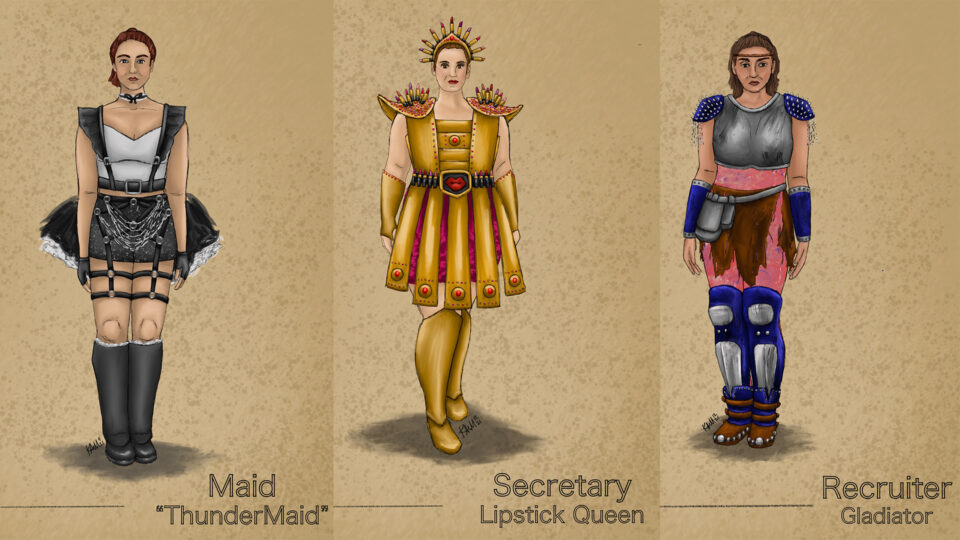
Maxwell Franko (Sound Designer): Musically, the “Thunderdome” sequence is meant to sound like you have front-row seats to the WWE final championship match. With influences from the industrial percussion of Mad Max, 80’s rock guitar and the cheers of thousands of adoring fans, the “Thunderdome” is a chaotic mass of sound piled into one pivotal scene.
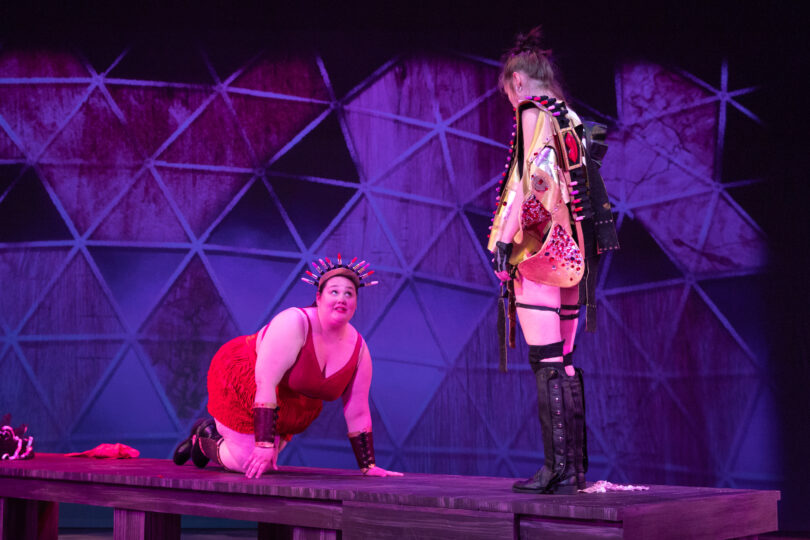
Ari Jamieson (Lighting Designer): My biggest inspiration for the “Thunderdome” in Murky as Hell was WWE entrances. I feel like it was important to the overhyped feeling of that section to make sure that each character has their own individual entrance that represents them. I also wanted the fight scenes to feel individual for those who are on stage.
Kelsey Oliver (Choreographer): This scene with the Vestal Virgins is a stance and an echo of bravery… and subconscious and conscious impacts on the body. There is a navigation through tough terrain, memory and visceral vulnerability. There is an embodiment of tension, judgement, guilt, anger, distrust and feeling unheard living in overlapping pathways. There are multitudes of reasons why words are kept inside until sometimes they aren’t. There are lingering, shadowy feelings. As the seeds of this choreography come from enormously heavy and complex stories, the approach has been to take value and time in the dramaturgy, research and ongoing group conversation. Words become the tool of power in this scene, which substantiates through honoring individualism and the impact of communal fortification.
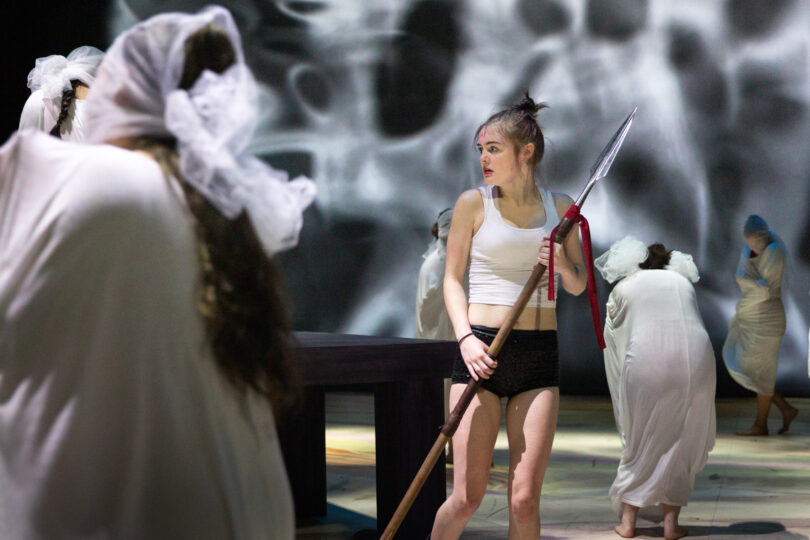
From start to final curtain, the design and creative collaborations in Murky as Hell help track the outward implications and inward significance of each scene, highlighting the extremes that are present within Hart’s script. Watch as these elements come together, presented as part of UTNT (UT New Theatre) in the Oscar G. Brockett Theatre.
Murky as Hell
Presented as part of UTNT (UT New Theatre)
March 4, 6 and 10, 2022
Oscar G. Brockett Theatre
TICKETS



